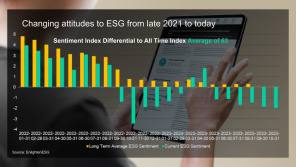

At the same time as Greta Thunberg called powerful leaders to account at the World Economic Forum in Davos with uncompromising demands, including to immediately divest from fossil fuels, South Africans faced daily power cuts.
For the country’s 59m people, no electricity meant no lights, no warm water, no internet and, in cases of emergency, no help.
South Africa is almost entirely powered by coal. But if the country abandoned fossil fuels overnight, millions would suffer. This raises an uncomfortable question: how can we save the planet without adversely impacting people’s lives?
Drawing on the concept of connected thinking, three interrelated forms of tension can be identified.
Philosophical tension: Art versus science of sustainability
Should we incorporate environmental, social and governance considerations because it is the right thing to do or because of hard evidence? The ambiguity in human behaviour highlights the importance of data in evidencing the benefits of ESG.
In 2018, the United Nations’ Exponential Climate Action Roadmap said the question was: “How do we provide governments, businesses and citizens with shared roadmaps that show the way?”
Key points
- Planning sustainability is a difficult challenge
- Companies incorporating sustainability have long-term prospects
- Exclusions filters are one way to be a sustainable fund
The report argued the data needed to create these roadmaps were already accessible, from government policies to emission statistics and research.
Yet significant issues remain in collecting data. As it is not mandatory, disclosure of ESG metrics is far from comprehensive, allowing exposed companies to not report their risks. Without clear deadlines it tends to be published with long delays.
Issues in data quality need to be balanced against our own ambiguity when interpreting and acting on information. This tension means our approach will hang in the balance between art and science; investors should embrace both.
Performance tension: Absolute versus relative sustainability
The cost-benefit analysis of incorporating ESG is another line of tension branching off in several directions, one of which is the question of investing in companies with a good ESG score versus those whose score is improving.
A 2018 Bank of America Merrill Lynch report showed the benefits of selecting above-average ESG-rated companies to avoid defaults. The caveat is that differentiating between correlation and causality can be difficult.

Yet even if it simply correlates to a lower cost of capital, a high ESG score can be a useful starting point when looking for consistent performers.
A high ESG score can also indicate a company’s durability; such companies typically focus on the resilience and sustainability of their business models. This will have left them better prepared for the disruption unleashed by Covid-19.
However, external ratings only show part of the picture. Family-run companies tend to have structures that do not fit with best practice; however, getting to know these businesses can separate those where cronyism is rife from those where management cares about doing the right thing.
Accounting for ESG’s dynamic nature is crucial. A timely judgment on a company’s ESG momentum can identify material risks that may be mispriced. These tend to evolve slowly but materialise abruptly. While this shows the urgency of integrating ESG into investment decisions, taking a long-term view is key.
Investors must also dig deeper than the sector level. For instance, Union Pacific has a low MSCI ESG score despite operating in a low-carbon sector: rail freight, where greenhouse gas emissions are 75 per cent lower than road freight. Our research found recurring incidences of alleged discrimination and weakened performance in safety metrics had weighed on the company’s rating.
Practical tension: Exclusion versus engagement
Green bonds should be a magic bullet for ESG. Unfortunately they have failed to attract the support that could have been expected, with prominent stakeholders calling for reforms.
The most popular implementation of sustainable policies involves exclusion filters, which apply to over 20 per cent of globally managed assets. However, exclusions present challenges; chief among them is that investors sacrifice the ability to engage.
Some choices are obvious. With 8m fatalities a year, tobacco remains the greatest cause of preventable death globally, not to mention having other harmful consequences: cigarette filters are the number one source of ocean plastic. We have taken a hard line not only on tobacco, but also coal and weapons.
In some funds, we exclude the world’s largest renewable energy provider – NextEra Energy – because more than 10 per cent of its revenues come from coal-power generation. On the other hand, we do not systematically exclude fast-food companies or airlines.
Exclusion considerations must be balanced against the positives of active ownership, where investors can hold management accountable.
Stewardship is key, and having the collective power to cast thousands of proxy votes allows investors to drive change. There have been significant wins – BP setting out its path to net zero is a recent example – but getting resolutions passed is only the start. Continued monitoring is resource-intensive and requires buy-in and persistence.
The structure of some asset classes makes engagement more difficult. Much like corporations, countries rely on capital markets for funding. Sovereign bondholders do not get a vote in electing public officials; however, countries that engage and implement sustainable laws tend to benefit from lower debt costs.
The temptation when dealing with complex ESG issues is to debate them to death without acting. In fact, embracing these complexities can transcend lines of tension to create better outcomes for societies, the environment and investors.
Francois de Bruin is fund manager, sustainable income & growth at Aviva Investors



